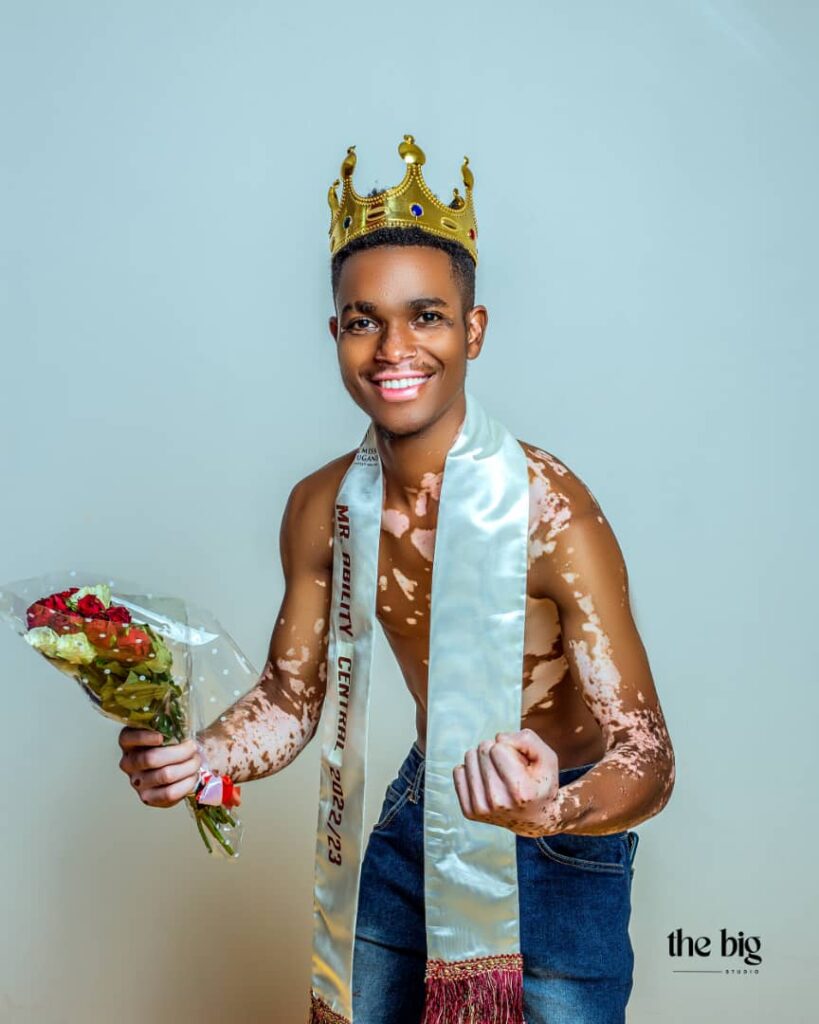At the age of six, Ibrahim Balinda saw a white patch suddenly emerging under his armpit. However his mother reassured him that it was a temporary skin condition which will be solved after seeing a dermatologist.
This prompted a visit to a nearby clinic, where he was informed that the skin condition resulted from a deficiency in certain minerals.
“I was prescribed medication, requiring me to take around 30 tablets daily and visit the clinic every three weeks for more. The costs became prohibitive for us, and with no noticeable improvement, we decided to discontinue the treatment,” he recounts.
After two months on medication and a specific diet, the situation worsened, with the patches spreading towards his chest.
A relative suggested consulting another skin specialist. After a second diagnosis, a dermatologist told the family that it was vitiligo, a chronic autoimmune disorder that causes patches of skin to lose pigment or color.
While some medical professionals offered a ray of hope, suggesting that the condition might heal over time, others asserted its permanence—indicating that he would have to live with it for the rest of his life.
Determined to regain clear skin, the family turned to herbal medicine, consuming various concoctions daily which resulted in “side effects including persistent vomiting, weight loss, and loss of appetite”.
With vitiligo spreading across his body, Balinda and his mother, influenced by neighbors’ advice, to seek treatment from traditional herbalists. This also was counterproductive.
Upon reaching the shrine, the witch doctor attributed the condition to family members who, having given birth to twins, had neglected traditional rites.
“I was feeling nervous and scared, but we had to follow the witch doctors’ instructions, bringing white eggs, a white hen, spears, backcloths, honey, coffee, and milk directly from a cow’s udder,
I was also instructed to bathe in a mixture of water, ghee, and herbs, after which I held back from washing for two days,” Balinda explains.
Despite religiously following these rituals and a series of incarnations, no positive outcome ensued, leaving him disappointed.

Ibrahim Balinda. Courtesy photo
Understanding Vitiligo!
As per the 2014 Journal of the Pakistan Association of Dermatologists, vitiligo impacts approximately 0.1%-2% of the general population. The research further underscores that the condition is characterized by multiple patches and exhibits no bias based on race, gender, or socioeconomic background.
Vitiligo can manifest at any age but is more commonly observed in individuals below the age of 20. It can be psychologically distressing, especially for those with darker skin tones, where the condition is more noticeable.
Dr. Ronald Katulebe, a dermatologist at the Kampala Dermatology Skin Clinic, defines vitiligo as an autoimmune disease and an acquired skin condition resulting from the loss of skin pigmentation known as melanin.
Melanin, a natural pigment responsible for skin color, is produced in cells called melanocytes.
Dr. Katulebe elaborates that the precise cause of the disease remains unknown, but various hypotheses suggest that it may be linked to the destruction of melanocytes. Consequently, he notes, “If a person lacks these cells, we observe the loss of body skin color.”
“While vitiligo is not entirely a genetic disease, a family with a history of vitiligo stands a chance of inheriting it. It runs in the bloodline of our families, yet the treatment of vitiligo remains unsatisfactory,” he adds.
According to research conducted by Mayo Clinic on vitiligo in 2022, the condition is not life-threatening or contagious. There is no cure for vitiligo; however, its spread can be managed, especially at an early stage.
“From my experience, individuals with vitiligo reported within a year are more treatable than those who seek treatment after 5-10 years. Another factor is the location of vitiligo; certain areas are easier to treat than others. For instance, the face is easier to treat than fingers, lips, and feet,” explains Dr. Ronald.
He notes that children respond more quickly to treatment compared to adults because their cells have not yet been affected by age. Additionally, treatment depends on the type of vitiligo; nonsegmental (affecting any side of the body) and segmental (affecting one side of the body).
Segmental vitiligo tends to be more resistant than nonsegmental.
Research highlights symptoms that can indicate vitiligo, are patchy loss of skin color appearing on the hands, face, areas around body openings, genitals, premature whitening or graying of hair on the scalp, eyelashes, eyebrows, or beard, and loss of color in the tissues lining the inside of the mouth and nose (mucous membranes).
The research further emphasizes that people with vitiligo are at a high risk of social or psychological distress, sunburn, eye problems, and hearing loss.
For individuals with vitiligo like Balinda, the doctor advises to protect themselves from direct sunlight by consistently using sunscreen whenever they are outdoors to prevent sunburns that can damage the skin.
Dr. Katulebe stresses that vitiligo is not the sole skin condition leading to the loss of skin pigmentation; therefore, seeking medical attention is crucial before reaching any conclusions.
“Some skin infections can result in color variation, and it is always advisable to consult a dermatologist for a proper assessment and diagnosis before attempting self-medication.”
Balinda’s change in skin color brought about considerable stigmatization from his peers, particularly during his time in secondary school.
As the vitiligo spread throughout his body, hiding it under his clothing became increasingly challenging.
The affected areas extended to visible parts such as the mouth, arms, hands, and neck, making even the school sweater inefficient.
“Fellow students distanced themselves from me. They believed the skin condition was contagious and feared its spread. They hesitated to include me in their study groups, and even simple acts like sharing scholastic materials such as a pencil became challenging.”
The discrimination he encountered resulted in a loss of focus on his studies as he struggled to find a purpose for education.
This intensified his desire to withdraw from school during his second year of senior education and initiate a poultry project at home with the assistance of his father.
‘I ventured into poultry farming, yet I consistently ended up with hens that had black and white spots, resembling me,” Balinda reveals.
Despite escaping the harassment from school bullies and finding solace in his poultry, Balinda remained in a state of depression, distancing himself from friends and completely isolating himself from the outside world for three years.
“I was worried about stepping outside and being visible to people because, on the rare occasions that I attempted, I could sense everyone turning to gaze at me.

Ibrahim Balinda poses for a photo moment after winning a disability beauty pageant in Kampala. Courtsey Photo.
Emerging from rejection and pain
In 2020, Ismail ibn Musa Menk, a distinguished global Islamic scholar from Zimbabwe, visited Uganda to deliver a sermon at Namboole Stadium in Mukono. Encouraged by his cousin’s brother, Balinda decided to attend the event and sought clothing that could cover him from head to toe.
“During the sermon, Mufti Menk imparted many teachings, one of which encouraged us to return home, look in the mirror, and reflect on what makes us special. When I got home, standing in front of the mirror, I undressed and questioned my identity. That moment, I decided to love, support, and be proud of myself,” he shared.
From that day forward, Balinda chose to emerge from isolation and engage more actively with the world.
He began taking strolls in the neighborhood, created social media accounts to reconnect with old friends, spent time with a few close companions, and attended family events, even though it was challenging.
At home, he refocused on his poultry business until the opportunity in modeling presented itself.
I am now a model!
Using social media platforms like Instagram and Facebook, Balinda began sharing some of my photos.
He got a lot of ratings about his farming work, attitude and appearance.
“Encouraged by the supportive feedback, I decided to expand my presence to TikTok, where I gained even more confidence. It was on TikTok that a professional magazine photographer noticed me and approached me for a photo shoot. Feeling prepared to showcase my skin to the world, I accepted the opportunity.”
For Balinda, a magazine appearance was an endorsement.
“I am genuinely content with my skin now. I have truly fallen in love with myself, and my journey with vitiligo has taken me to incredible places. People appreciate it, want to touch and feel it, and even take pictures with me.”
Balinda finds company in the likes of Canadian supermodel Winnie Harlow, who has achieved remarkable success on international runways despite her vitiligo.
Additionally, the late pop musician Michael Jackson, who passed away in 2009, also stood as a prominent figure with vitiligo.
Presently, Balinda aspires to establish a personal brand as a vitiligo model, utilizing his voice to raise awareness about skin conditions.
His goal is to inspire and support others living with vitiligo, encouraging them to embrace and be comfortable in their own skin.
Recent News
© 2022 - Media Challenge Initiative | All Rights Reserved .


